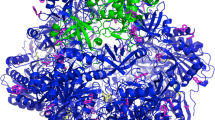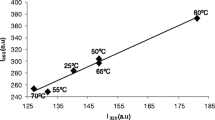Abstract
Equilibrium unfolding of a 69-kDa monomeric Escherichia coli maltodextrin glucosidase (MalZ) was studied using intrinsic and extrinsic fluorescence spectroscopy. The unfolding transition of MalZ followed a three-state process, involving the formation of a stable intermediate state having more exposed hydrophobic surface. It was found that the protein structure can be easily perturbed by low concentration of guanidium hydrochloride (GdnHCl) and, at a GdnHCl concentration of 2 M, MalZ was denatured completely. The active site of the protein also has been proved to be sensitive to a low concentration of GdnHCl since MalZ deactivated at 0.5 M GdnHCl completely. The surface hydrophobicity and ANS-binding site of the protein have been determined to be 150.7 and 0.24, respectively. Perhaps the formation of the stable unfolding intermediate, having higher surface hydrophobicity, may be one of the reasons for aggregation of MalZ and its recognition by chaperonin GroEL during the assisted folding pathway.







Similar content being viewed by others

References
Anfinsen, C.B.: Principles that govern the folding of protein chains. Science 181, 223–230 (1973). doi:10.1126/science.181.4096.223
Ikemura, I., Takagi, H., Inauye, M.: Requirement of pro-sequence for the production of active subtilisin in Escherichia coli. J. Biol. Chem. 262, 7859–7864 (1987)
Silen, J.L., Agard, D.A.: The alpha-lytic protease pro-region does not require a physical linkage to activate the protease domain in vivo. Nature 341, 462–464 (1989). doi:10.1038/341462a0
Winther, J.R., Sorensen, P.: Propeptide of carboxypeptidase Y provides a chaperone-like function as well as inhibition of the enzymatic activity. Proc. Natl. Acad. Sci. USA 88, 9330–9334 (1991). doi:10.1073/pnas.88.20.9330
Matthews, C.B.: Pathways of protein folding. Annu. Rev. Biochem. 62, 653–683 (1993). doi:10.1146/annurev.bi.62.070193.003253
Rudon, R.W., Bedows, E.: Assisted protein folding. J. Biol. Chem. 272, 3125–3128 (1997). doi:10.1074/jbc.272.6.3125
Finkelstein, A.V., Ptitsyn, O.B.: Why do globular proteins fit the limited set of folding patterns? Prog. Biophys. Mol. Biol. 50, 171–190 (1987). doi:10.1016/0079-6107(87)90013-7
Tapio, S., Yeh, F., Shuman, H.A., Boos, W.: The malZ gene of Escherichia coli, a member of the maltose regulon, encodes a maltodextrin glucosidase. J. Biol. Chem. 266, 19450–19458 (1991)
Paul, S., Singh, C., Mishra, S., Chaudhuri, T.K.: The 69 kDa Escherichia maltodextrin glucosidase does not get encapsulated underneath GroES during GroEL/GroES assisted folding. FASEB J. 21, 2874–2885 (2007). doi:10.1096/fj.06-7958com
Chaudhuri, T.K., Das, K.P., Sinha, N.K.: Surface hydrophobicity of a low molecular weight basic trypsin subtilisin inhibitor from marine turtle eggwhite. J. Biochem. 113, 729–733 (1993)
Cardamone, M., Puri, N.K.: Spectrofluorimetric assessment of the surface hydrophobicity of proteins. Biochem. J. 282, 589–593 (1992)
Tanksale, A., Ghatge, M., Deshpande, V.: α-Crystallin binds to the aggregation-prone molten-globule state of alkaline protease: Implications for preventing irreversible thermal denaturation. Protein Sci. 11, 1720–1728 (2002). doi:10.1110/ps.0201802
Sanz, J.M., Gimenez-Gallego, G.: A partly folded state of acidic fibroblast growth factor at low pH. Eur. J. Biochem. 246, 328–335 (1997). doi:10.1111/j.1432-1033.1997.00328.x
Kato, A., Nakai, S.: Hydrophobicity determined by a fluorescence probe method and its correlation with surface properties of proteins. Biochim. Biophys. Acta 624, 13–20 (1980)
Matulis, D., Lovrien, R.: 1-Anilino-8-naphthalene sulfonate anion-protein binding depends primarily on ion pair formation. Biophys. J. 74, 422–429 (1998)
Jones, S., Thornton, J.M.: Analysis of protein-protein interaction sites using surface patches. J. Mol. Biol. 272, 121–132 (1997).
Acknowledgements
We thank Professor Winfried Boos, Konstanz, Germany for the gift of plasmids encoding His-tagged MalZ. The authors gratefully acknowledge financial support from the Department of Science and Technology, Govt. of India and Ministry of Human Resources and Development (MHRD), Govt. of India.
Author information
Authors and Affiliations
Corresponding author
Rights and permissions
About this article
Cite this article
Paul, S., Kundu, M., Das, K.P. et al. Unfolding Studies of Escherichia coli Maltodextrin Glucosidase Monitored by Fluorescence Spectroscopy. J Biol Phys 34, 539–550 (2008). https://doi.org/10.1007/s10867-008-9117-9
Received:
Accepted:
Published:
Issue Date:
DOI: https://doi.org/10.1007/s10867-008-9117-9



